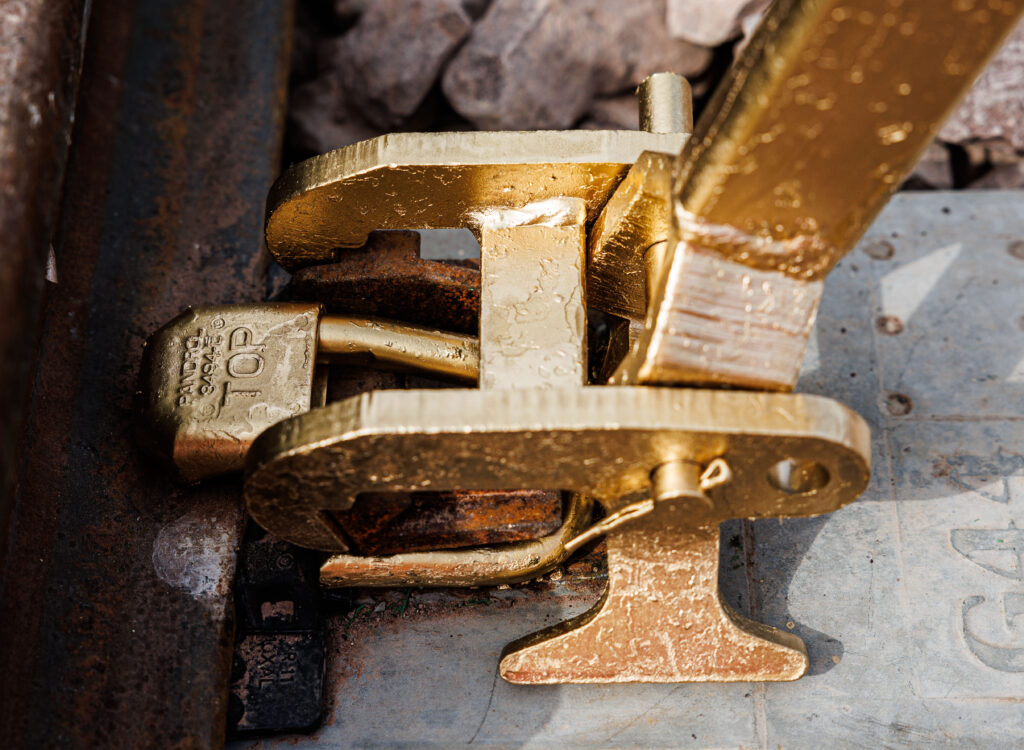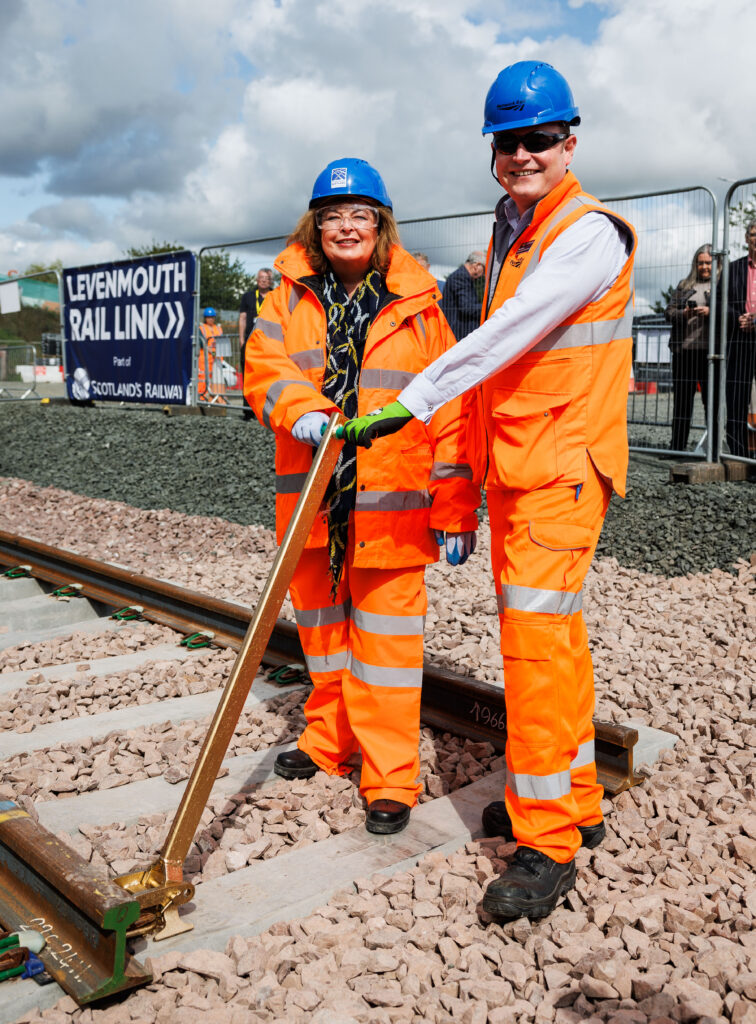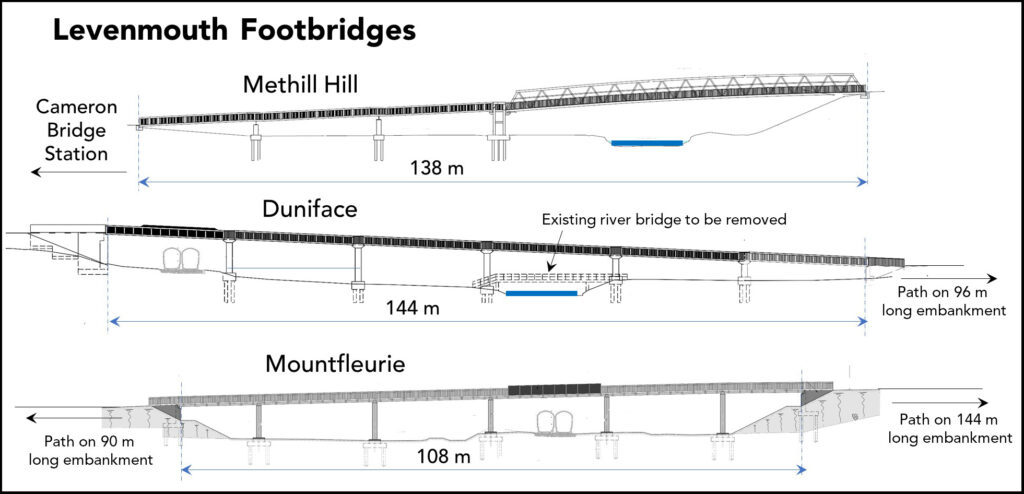On 25 August, Scotland’s Transport Minister, Fiona Hyslop and Alex Hynes, managing director of Scotland’s Railway installed the final golden pandrol clip to mark the completion of track laying on the Levenmouth Rail Link project. This work entailed laying 19km of track over a number of phases since March 2022.
Rail Engineer explained how this track laying was done in issue 200 (Jan-Feb 2023) and the nature of this project and its preparatory work in issue 197 (Jul-Aug 2022). To recap, this project is reopening a mothballed line which was closed to passenger services in 1969. Leven last saw freight services in 2001. The Levenmouth area is the largest settlement in Scotland without a rail link and is generally a deprived area due to the closure of its coal mines and other industries.
With the completion of track work, Rail Engineer was on site in October to see what remained to be done to complete the job.
Regenerating Levenmouth
Since 2014, the Levenmouth Rail Campaign (LMRC) has proposed regenerating the Levenmouth area by re-opening this closed line. This resulted in a debate in the Scottish Parliament in September 2017 which showed strong cross-party support for its reopening. The case for the line was made in the LMRC’s booklet which the Transport Minister endorsed during this debate. He then announced that Transport Scotland would undertake a study on the best travel options for the area.
Booklet explaining both the benefits and issues associated with the line’s re-opening
After this study reported in favour of a re-opened railway, in August 2019 the Scottish Government announced the go-ahead for detailed design work to support its re-opening. Devegetation work started late in 2020 and was followed by site investigations early in 2021. In January 2022, the Scottish Government confirmed that £117 million was to be invested in the Levenmouth railway and that it will open in spring 2024. The first mile of track from Thornton North Junction was laid and the first construction compounds were establishment in March 2022.

For almost all its length, the 9.7km long Levenmouth branch has few straight sections. Hence its line speed is generally 45mph. From its junction with the main line, it closely follows the River Ore in a steep valley and then populated area by the River Leven. Although it had single track when it closed to passenger services, to ensure timetable resilience, the reopened railway is double track except for a 1.5km single line section from Thornton North Junction.
The project’s aim is to make “Levenmouth a better place to live, work and play” and is being delivered on behalf of the Scottish Government with Network Rail in the lead with AmcoGiffen, AtkinsRéalis, BAM, Siemens, SPL, Story, QTS, and Rail Systems Alliance Scotland (RSAS) as suppliers.
This report is based on my site visit which focused on progress at the line’s two stations. Figures in brackets are metres from Thornton North Junction.
Leven station
Leven (9,654) is the end of the line and so was the site of the golden clip ceremony. When completed, its station will have a single seven-metre-wide, 205-metre-long island platform, accessed by a ramp between the buffer stops. A pavilion between the buffer stops and car park will contain a waiting area, ticket machines, and a welfare facility for Scotrail staff. Separate cycle storage will be located adjacent to the pavilion. An additional waiting shelter will be provided on the island platform.
Its car park will have 133 spaces, including 12 for electric cars. To create a quality public realm, the area around the station is the subject of a placemaking study which is considering a central boulevard and waterfront path from station to town.
The Principal Contractor for the station works is AmcoGiffen. At the time of my visit around 40 metres of the station platform had still to be constructed. This platform is crossed by the 75-year old River Leven Road (Bawbee) bridge which was in poor condition and required new abutments and redecking. This work is the responsibility of Fife Council who agreed that it should be managed by the project team as it is an integral part of the work to reopen the railway. Hence, work on part of the Leven platform was deferred until the bridge work was substantially complete.
This bridge work also required the provision of a temporary road with a temporary bridge over the River Leven which was brought into use in May. This also has an interface with the station as the raised road to it will have to be levelled for the construction of the station car park. This work cannot start until the Bawbee bridge re-opens.
The Bawbee bridge takes its name from the toll to cross the original chain-suspension footbridge built in 1821. This was a halfpenny or, in Scots, a Bawbee.
Cameron Bridge
The other station on this line is at Cameron Bridge (6,480). Its car park will have 125 spaces and there is room for a further 300 spaces should these be required after the railway opens. This is quite likely as the station is situated off the busy A915 road which runs through Fife’s East Neuk to St Andrews and so it could be a significant rail head for the area.
There are 8,000 people living within 2km of the station. This includes the settlement of Methilhill which is to be connected to the station by a 140-metre long footbridge over the River Leven, consisting of 2 x 21-metre and one 70-metre spans. As described later this is being provided by a separate active travel project.


The station consists of two 196-metre platforms with a footbridge and lifts. Like Leven it will have a Pavilion structure with a waiting area and ticket machines. There will also be storage for 16 cycles.
Work on the station started in January. At the time of my visit the platforms were almost complete, and the footbridge and lift-towers recently installed. The bridge was fabricated by M&S engineering of Dumfries and installed in 11 separate lifts over two days in September.
Signalling and electrification
The line is double-track except for a single line section from Thornton North Junction (0) to Double Dykes Junction (1,451). The only other point-work is the crossovers before Leven’s terminal platforms. For trains leaving Leven there is a Down to Up line crossover (8,800) with a Down to Up line crossover (9,230) for trains approaching Leven.
With most of the route being double-tracked, the signalling headways allow for at least a twice-hourly train service. Train detection at Leven station and on the branch’s single-line section at its fringe with the Fife Circle is D.C. track circuits. Elsewhere, 22 Frauscher axle counters have been installed. In total, the line requires 15 signals. These, and other trackside equipment, are controlled by factory-built location cases throughout the route. The line’s signalling system uses Siemens Mobility’s Trackguard Westrace Trackside System to interface with the trackside equipment, in conjunction with the company’s Trackguard Westlock Computer Based Interlocking.
The line requires two GSM-R masts to be installed. One will be at Cardowie (2840) and another at Pfaudler’s Yard (9200) which is also the location of the signalling Principal Supply Point. Both this and the GSM-R mast had yet to be installed during my visit though I was advised that troughing was 95% complete.
The Scottish Government’s plan to decarbonise its railway includes an interim plan for partial electrification of the Fife lines. This requires electrification of the Levenmouth branch. However, with orders yet to be placed for the required battery EMUs, it will be some time before Fife and its Leven branch see electric trains. To minimise the disruption and cost of the branch’s future electrification, foundations are being installed as an integral part of the construction work. As this is being done in accordance with the completed electrification detailed design for its electrification, there will be no infrastructure clashes or signal sighting issues when the line is electrified.
Bridge parapets are also being raised to the height required by electrification standards. During my visit, around 60% of the required 365 foundations had been installed.
The project completion programme requires rail corridor work to be completed by 4 December for progressive commissioning of the route with signalling commissioning planned to take place on 7 January. This will see the line controlled by Edinburgh Signalling Centre when it will become part of the main line network. It will also enable driver training to commence.
Then the only significant work remaining will be the two stations which are planned to be completed in Spring 2024.
Crossing the line
Whilst the line was mothballed, it was crossed by various paths. For understandable reasons, Network Rail was unable to create level crossings on the line. Hence, various paths across the line had to be closed where the significant cost of a footbridge could not be justified.
This was not such a problem at the populated eastern end of the line where the Leven Programme aims to make the area a hub for tourism, business, and industry. This is a partnership of various organisations including the Scottish Environmental Protection Agency (SEPA), Scottish Natural Heritage, Sustrans, Fife Council, and Scottish Enterprise.
This programme aims to maximise opportunities for active travel in Levenmouth along a 5km stretch of the river from Cameron Bridge to Leven. It is part-funded by the Scottish Government’s Places for Everyone programme. In addition, Fife Council received £19.4 million from the UK Government’s Levelling Up Fund for the Leven Connectivity Project and Glenrothes Riverside Park.
Though the Leven programme is outside the scope of the rail link project, Network Rail is working closely with it to minimise its cost and has submitted planning applications for three footbridges which will become part of this active travel network. With low land by the River Leven and disused coal mines in the area, these planning applications required flood and mining risk assessments.
These footbridges are:
- Methilhill (6,400), a 138-metre footbridge over the River Leven between Methilhill and the Up platform at Cameron Bridge station. This has a 72-metre span over the river and 3 x 22-metre spans over the low ground.
- Duniface (7,070), a 144-metre footbridge of 6 x 24-metre spans over the railway and the River Leven. This carries a Fife Core Path between Methilhill and Kennoway.
- Mountfleurie (8,270), a 108-metre footbridge of 2×14-metre and 4×20-metres spans over the railway and Fife Heritage Railway. This carries a Fife Core Path between Kirkland and Mountfleurie.

The paths over the line at Duniface and Mountfleurie will remain open until planning consents have been received and work to construct new bridges gets underway.
The thinly-populated western part of the line has four crossing points. These are not core paths or have no legal rights of way and were permanently closed in August. One of these, at Double Dykes (1,196), attracted a petition calling for it to remain open which collected 1,400 signatures with the local MP raising this matter in the Westminster Parliament. This is an unfortunate example of how it can be difficult to build a railway without upsetting some of the local population.
At Woodbank (4,900) a three-hectare field bounded the Rivers Leven and Ore was accessed by a path across the railway. To maintain the farmer’s access, an underpass was constructed. This incorporated two-metre-square and three-metre-square precast box units for pedestrian and vehicular access. Earthworks were required to provide a 1:7 slope to this underpass.
The timetable challenge
To present a balanced view, the campaigner’s booklet explained the issues that had to be addressed to reinstate passenger services as well as making the case to re-open the line. This showed that, whilst the Levenmouth construction works were relatively straightforward, developing a timetable to provide the required connectivity would be a significant challenge.
With track and station capacity on the existing routes to and through Fife constrained, the booklet considered that accommodating trains on an additional route would demand considerable ingenuity as well as resources of trains and crews.

This point was highlighted in ScotRail’s recent consultation about its interim 2024 Fife timetable to provide Leven with a train service. This was needed as the required trains and traincrew for the desired service will not become available until 2025.
The current off-peak timetable gives Fife four stopping services per hour. Two of these go through Kirkcaldy to Perth or Dundee, and two go through Dunfermline to terminate at Cowdenbeath or Glenrothes. Following electrification elsewhere, this is now ScotRail’s most intense urban diesel service and requires about a third of its 74 DMUs operating services out of Edinburgh.
When the new line opens, the challenge for train planners is to give the Levenmouth branch an acceptable service with the available trainset and crew resources whilst not detracting from the existing timetable. A further requirement is to give Leven a journey time of around an hour from Edinburgh. A journey time of around 65 minute is possible via Kirkcaldy, though the route via Dunfermline takes about 80 minutes.
As shown in the table, the published 2025 off-peak timetable offers Leven two trains an hour, one via Kirkcaldy and one via Dunfermline. This requires a 30% increase in train utilisation time which requires six additional DMUs which will not be available when the line opens.
Hence, an interim timetable is needed in 2024. For consultation, ScotRail produced two options for this which requires a 20% increase in train time and four additional DMUs. Option A offers Leven two trains an hour via the longer Dunfermline route, whilst option B offers a less frequent but faster service with one train an hour via the Kirkcaldy route.
Some of the additional units will be released from electrification schemes. Barrhead is soon to be completed and East Kilbridge should be completed in 2025.
When the Levenmouth train service starts, three trains will be stabled overnight in Leven where there will be a small train crew depot. The service will initially be operated by Class 158 and Class 170 DMUs.
Levenmouth regeneration
Although the line’s opening date has yet to be announced, it seems likely that it will re-open close to the date of the summer timetable in May or June in LMRC’s 10th anniversary year. This shows how long it takes to justify the large cost of re-opening a railway and then to design and build the line.
It will also then be about nine years since Scotland opened its last new line, the 49km Borders Railway, to Galashiels and Tweedbank at a cost of £445 million (2023 prices). With over a million journeys a year on this line, passenger numbers greatly exceeded expectation. This has acted as a catalyst for investment and opened up employment, leisure, and passenger opportunities for those along the line.
£117 million for the 10km Levenmouth branch is not cheap, yet, like the Borders Railway, it will no doubt greatly benefit the area. Like the Borders Railway, its journey time to Edinburgh will be about an hour which is much less than the bus alternative. The rail project is also linked to other regeneration projects to attract investment which Fife Council anticipates will be equivalent to its construction cost.

As Joe Mulvenna, Network Rail’s project manager, notes: “The new line will improve social and economic opportunities for people in the surrounding communities and we are working hard with local partners to maximise the positive impact the project will have right across the area.”
For Joe and his team, this project is about improving the lives of the people of Levenmouth by creating economic growth and new opportunities.
The project also recently launched its Rail Skills Academy, to give young people the skills and work experience to work in the railway maintenance sector. This ran over nine weeks and was delivered by QTS training. Around the same time, the project also welcomed 200 students over a three-day period who took part in four workshops to give them an understanding of how technology was used to design the railway and how it is being built and will be maintained.
Such initiatives are part of the project team’s objective which was “to make Levenmouth a better place to live, work and play.” Whilst the design and construction of a new railway is a demanding challenge, ultimately the real objective is to maximise the benefit to the local community. This is what railways do and all the evidence shows that Levenmouth will start to realise these benefits in a few months’ time.
Rail Engineer thanks Network Rail’s Joe Mulvenna, Kirsty Ryder, and Owen Campbell for their help with this feature.

